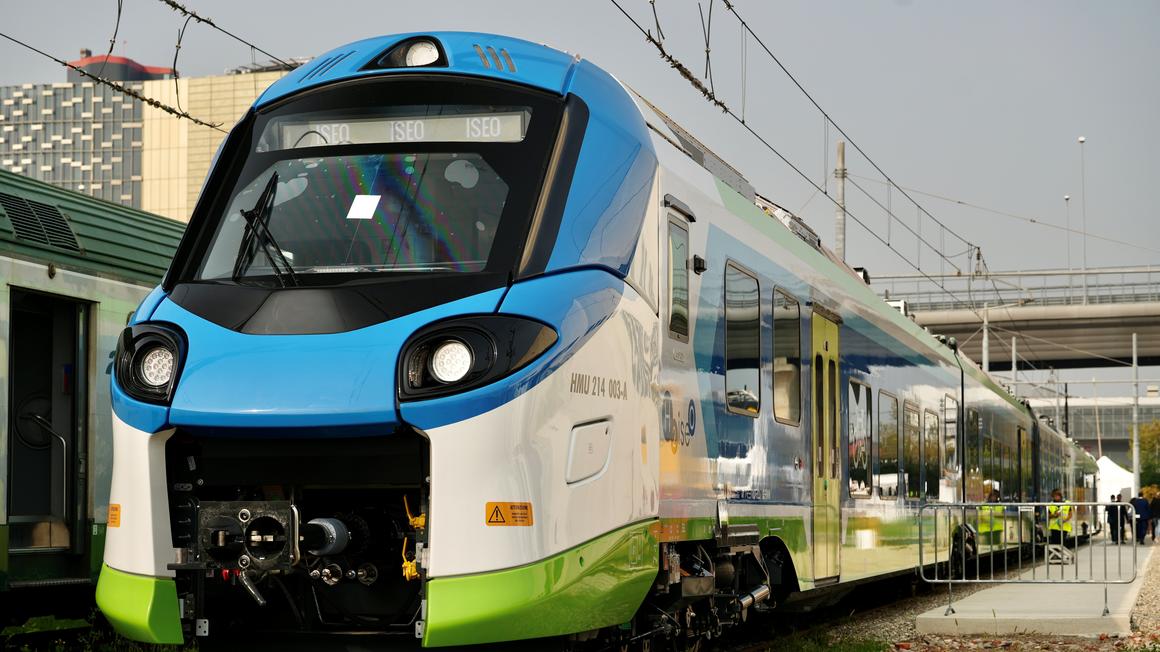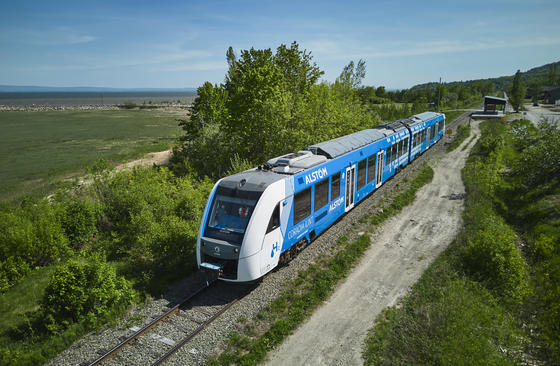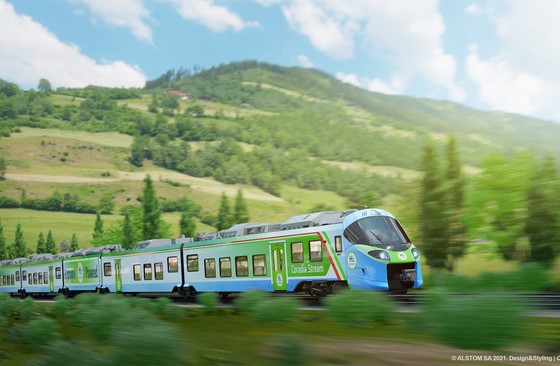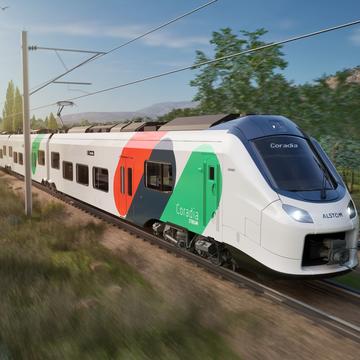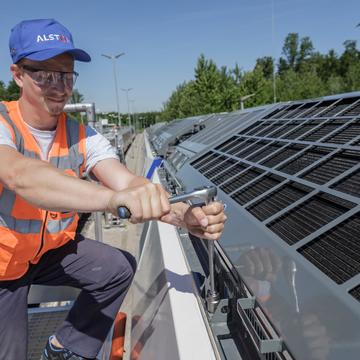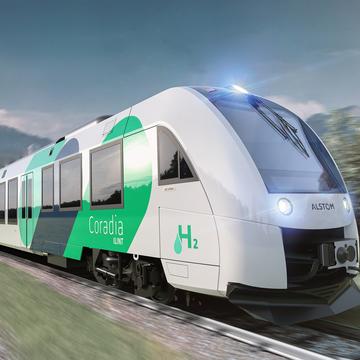
FNM and Alstom present Italy's first hydrogen-powered train
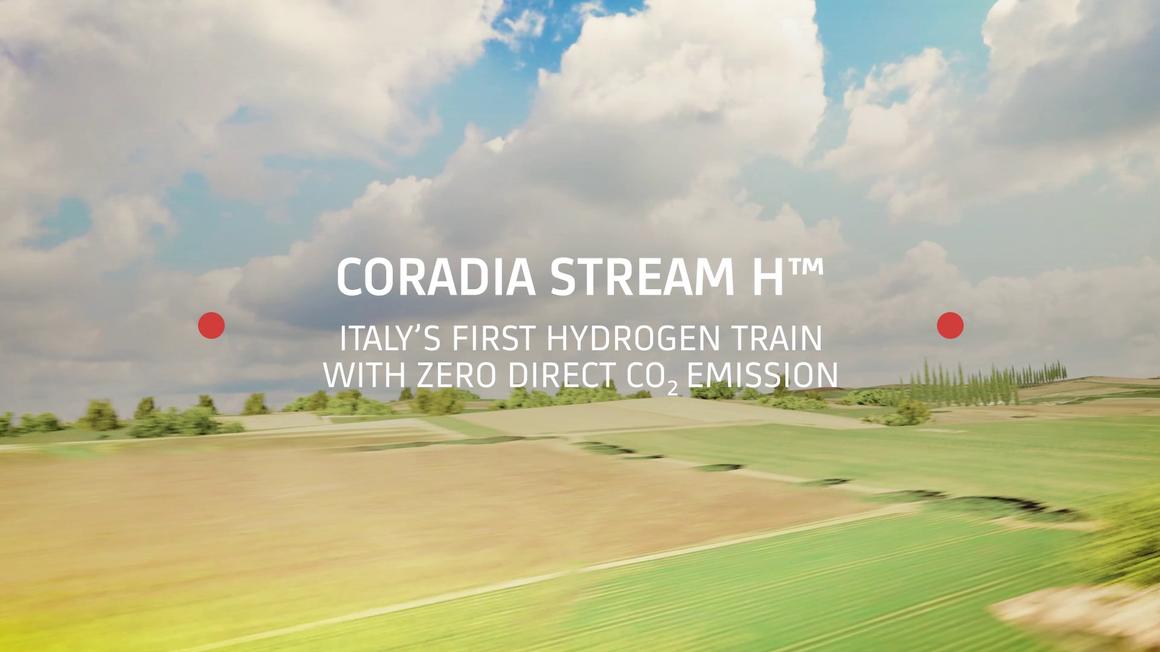
Press contact - Samuel Miller
Samuel Miller
Send an emailPress contacts - Italy
Gaia Mazzon
Send an email-
Today's event follows the agreement signed in November 2020 to supply Trenord with six hydrogen fuel cell trains with an option for an additional eight
-
After a testing phase, the train will enter commercial service within Italy's first Hydrogen Valley, located in Valcamonica along the Brescia-Iseo-Edolo line
-
The hydrogen-powered Coradia Stream meets the European goal of completely reducing CO2 emissions by 100 percent by 2050
3 October 2023 – FNM, the leading integrated group in sustainable mobility in Lombardy, presented today, jointly with the manufacturer Alstom, global leader in smart and sustainable mobility, the hydrogen-powered Coradia Stream train that marks the beginning of a new era in passenger rail transport in Italy. The event was held as part of EXPO Ferroviaria 2023. The train will enter commercial service in Valcamonica between the end of 2024 and the beginning of 2025, along the non-electrified Brescia-Iseo-Edolo line of FERROVIENORD on which the rail service is operated by Trenord, as part of the H2iseO project, which aims to create Italy's first Hydrogen Valley in the area of Brescia. The hydrogen-powered Coradia Stream meets the European target of reducing CO2 emissions by 100 percent by 2050 and is the first zero direct CO2 emission train for Italy equipped with hydrogen fuel cells, with a total capacity of 260 seats and a range of more than 600 km.
The presentation ceremony was attended by Sen. Matteo Salvini, Vice-President of the Council of Ministers and Minister of Infrastructure and Transport, Sen. Alessandro Morelli, Undersecretary of State to the Presidency of the Council of Ministers, the Lombardy Region, present with Councillors Franco Lucente (Transport and Sustainable Mobility), Claudia Maria Terzi (Infrastructure and Public Works). Also speaking were FNM President Andrea Gibelli, FERROVIENORD President Fulvio Caradonna, Trenord President Federica Santini, Trenord CEO and FNM General Manager Marco Piuri, Alstom President of Europe Region Gian Luca Erbacci, and Alstom Italy General Manager and President and CEO of Alstom Ferroviaria, Michele Viale.
Today's event follows the agreement signed by FNM and Alstom in November 2020 to supply Trenord with six hydrogen fuel cell trains, with an option for eight more. The introduction of the hydrogen train is part of the H2iseO Hydrogen Valley project.
-
1stThe first zero direct CO2 emission train for Italy equipped with hydrogen fuel cells
-
260A total capacity of 260 seats
-
600kmA range of more than 600km
Promoted by FNM, FERROVIENORD and Trenord, H2iseO aims to develop an economic and industrial hydrogen supply chain in Valcamonica, starting from the mobility sector, initiate the energy conversion of the territory, and contribute to the decarbonisation of a significant part of local public transport. It is a highly innovative project, which envisages, among other things, the construction of 3 plants for the production, storage and distribution of renewable hydrogen without CO2 emissions (in Brescia, Iseo and Edolo), as well as the commissioning of 40 hydrogen buses to replace the entire fleet used today by FNM Autoservizi.
The new hydrogen-powered trains are based on the model of Alstom's single-deck Coradia Stream regional train, aimed at the European market and already produced by Alstom in Italy. The hydrogen-powered Coradia Stream will maintain the high standards of comfort already appreciated by passengers in its electric version and will provide the same operating performance as diesel trains, including range. The hydrogen-powered Coradia Stream can operate on non-electrified lines as a replacement for trains using fossil fuels, and offers comfort and quietness characteristics comparable to other electric Coradia models, with a range of more than 600 km.
The train was created and produced at Alstom's plants in Italy, involving the Savigliano site for development, certification, production and testing, the Vado Ligure site for the outfitting of the "power car" in which the technologically innovative hydrogen-related part is installed, the Sesto San Giovanni site for components and the Bologna site for the development of the signalling system.
"The hydrogen train will be the protagonist of Italy's first Hydrogen Valley, located in Valcamonica along the non-electrified Brescia-Iseo-Edolo line, and will replace the current diesel trains."
"Today's event marks a milestone in the journey started by the FNM Group in November 2020 with H2iseO," explained FNM President Andrea Gibelli. "This is a project with a high innovation content, embracing social, economic, geographic, environmental and mobility dimensions, and it has great value in terms of sustainability because it allows us to use the already existing railway infrastructure by putting new hydrogen trains into service, which are able to cut emissions, contribute to the decarbonisation of mobility in the valley and ensure greater comfort for travellers. In addition, the creation of an economic and industrial district based on hydrogen, starting with but not limited to rail mobility, will have positive effects on the economy and employment in the area."
“FERROVIENORD is working hard to build the plants and related infrastructure in preparation for the train's test phase and commercial service," stressed FERROVIENORD President Fulvio Caradonna. “Everything is being carried out with the utmost attention to the issue of safety and sustainability, and it could not be otherwise. The development of projects and the construction of works follow strict procedures from this point of view.”
"We are proud to be here today together with FNM to present the first hydrogen-powered train that will enter service in the Italian railway system. A project that represents significant progress for the entire rail sector and confirms Alstom's role in anticipating and shaping the future of mobility with new, highly sustainable transportation solutions." - said Michele Viale, General Manager of Alstom Italy and President and CEO of Alstom Ferroviaria. "The hydrogen train will be the protagonist of Italy's first Hydrogen Valley, located in Valcamonica along the non-electrified Brescia-Iseo-Edolo line, and will replace the current diesel trains."
"Strong mobility is the first area of application for hydrogen," commented Marco Piuri, CEO of Trenord and General Manager of FNM. "Inaugurating the use of this technology in an area that connects, by vocation, means that its value will not only be realised in the individual project, but will spread to other areas. I am thinking of industries and services that can be reached by the hydrogen network. This is what we aim to achieve with H2iseO: we want it to be scalable, beyond rail and bus mobility. Only this will allow us to truly bring a Hydrogen Valley to life. H2iseO is a step in a broader journey: in recent years, we have been progressively renewing the fleet in Valcamonica, moving from old diesel railcars to the more modern ATRs, which are better performing and less polluting, and finally to hydrogen. What does this mean? That we will pass through small villages releasing water vapor instead of the black smoke of a few years ago."
Federica Santini, President of Trenord, said, "Sustainability is our goal and also our trajectory. The hydrogen-powered train is an essential piece of this path that is being built in Trenord's daily progress. Being sustainable for us means using a process of co-innovation, shared with various realities of our complex ecosystem, to develop well-rounded projects that grow corporate culture, characterise industrial processes, and ground solutions that are compatible with environmental protection, energy conservation, and the use of technology to serve citizens. The hydrogen train-along with more than 200 new trains and the digitisation of sales systems-becomes today the protagonist of this ideal line of corporate growth that serves, first and foremost, the sustainable lives of our customer-travellers."
Alstom has been a supplier and maintainer for FNM Group for more than 15 years. During this time, Alstom has contributed to the operation and maintenance of more than 100 single-deck EMU trains, including 60 Coradia Stream units and 90 E464 locomotives.
How the hydrogen train works
The intermediate railcar called the "power car" in which the heart of hydrogen technology resides is the main source of energy. Energy is provided by the combination of hydrogen (stored in tanks) with oxygen from the outside air, without emitting CO2 into the atmosphere. High-performance lithium-ion batteries store the energy, which is later harnessed during acceleration phases to support the action of the hydrogen cells and ensure fuel economy.
Alstom™, Coradia™ and Coradia Stream™ are protected trademarks of the Alstom Group.
